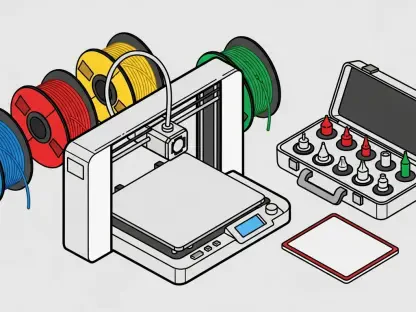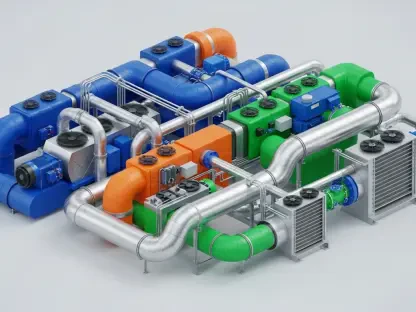In the intricate world of precision mechanical engineering, the selection of materials stands as a cornerstone that can determine the success or failure of critical components like gears, bearings, and seals. Across industries ranging from heavy machinery to life science equipment, the choice of material profoundly influences performance, durability, and cost-effectiveness. Engineers face the daunting task of aligning mechanical properties, environmental resilience, and economic constraints to ensure components operate flawlessly under demanding conditions. This exploration delves into the multifaceted process of material selection, uncovering the key drivers, inherent trade-offs, and groundbreaking innovations that shape decisions in this field. By examining insights from industry leaders, the discussion reveals how strategic material choices not only solve immediate technical challenges but also contribute to long-term reliability and sustainability in precision mechanical systems.
Performance at the Core of Material Decisions
When it comes to designing precision mechanical parts, performance remains the paramount factor guiding material selection. Components must meet stringent application-specific demands, whether it’s a gearbox enduring high shock loads or a bearing maintaining stability under extreme speeds. Experts emphasize that mechanical properties such as tensile strength, wear resistance, and fatigue endurance are non-negotiable in ensuring a part’s reliability. For instance, in industrial gearboxes, metals with exceptional strength are often prioritized to handle intermittent stress without deformation. Similarly, bearings require carefully engineered microstructures to achieve thermal stability and longevity. If performance criteria are not met, even the most budget-friendly material risks leading to premature failure, resulting in costly downtime or compromised safety across critical systems.
Beyond mechanical attributes, environmental and chemical performance plays a pivotal role in material choices, especially in specialized fields like life sciences. Components in these applications must withstand aggressive chemicals, frequent sterilization, and millions of operational cycles without degrading or contaminating sensitive environments. High-purity stainless steels, fluoropolymers, and advanced elastomers often emerge as ideal solutions due to their resistance to corrosion and chemical breakdown. This dual emphasis on mechanical robustness and environmental compatibility highlights the intricate nature of material decisions. Engineers must anticipate real-world conditions to select materials that ensure consistent performance, safeguarding both functionality and safety in highly specialized applications.
Balancing Act: Cost, Availability, and Performance Trade-offs
Material selection for precision mechanical parts inevitably involves navigating a complex web of trade-offs between performance, cost, and availability. High-performance materials, such as specially processed steels for bearings, often deliver superior lifespan and reliability but come with elevated costs and extended lead times. In contrast, more accessible and affordable options may suffice for less demanding applications, where absolute peak performance is not critical. This balancing act challenges engineers to make pragmatic decisions, ensuring that chosen materials meet essential requirements without overburdening project budgets or timelines. Striking this equilibrium is vital in industries where financial constraints and delivery schedules are as pressing as technical specifications.
To mitigate these trade-offs, many companies adopt flexible material offerings that cater to diverse needs without resorting to expensive custom solutions. Standard parts with customizable material options provide a faster, more cost-effective alternative, enabling engineers to tailor components to specific applications while maintaining efficiency. Additionally, the development of proprietary material blends, such as specialized plastics for bearings, offers a spectrum of performance levels at varying price points. This approach allows for precise matching of material properties to operational demands, ensuring that neither performance nor economic viability is sacrificed. Such strategies demonstrate how adaptability in material selection can address the inherent challenges of balancing quality with practicality.
Pushing Boundaries with Testing and Material Innovation
Innovation in testing and material development is revolutionizing the approach to selecting materials for precision mechanical components. Advanced analytical techniques, such as ultrasonic testing and detailed microscopy, enable companies to assess material properties with remarkable precision. This data-driven methodology ensures that materials are matched to specific application needs, optimizing performance while controlling costs. For example, detailed analysis of steel inclusions in bearings helps identify compositions that enhance durability under high-stress conditions. These cutting-edge testing methods reduce uncertainty in material selection, allowing engineers to make informed decisions that enhance the reliability and efficiency of mechanical systems across various industries.
Equally significant is the ongoing development of novel materials tailored to address unique challenges. New alloys designed for wind turbine bearings, for instance, improve strength while reducing energy consumption during manufacturing. Similarly, self-lubricating plastics have emerged as game-changers in food processing applications, eliminating contamination risks associated with traditional lubricants. These material advancements not only elevate performance but also align with broader goals like environmental sustainability by minimizing resource use and waste. As companies continue to invest in research and development, the landscape of material options expands, offering engineers an ever-growing toolkit to tackle the most demanding precision engineering challenges with innovative solutions.
Application-Driven Solutions for Unique Challenges
The diversity of applications for precision mechanical parts necessitates a highly tailored approach to material selection. Each use case presents unique operational and environmental demands that must be addressed to ensure optimal performance. In food processing environments, for instance, replacing traditional metal bearings with FDA-compliant plastic alternatives eliminates the need for lubricants, significantly reducing contamination risks while also lowering maintenance costs. This shift not only enhances safety but also streamlines operations, demonstrating how material choices can directly impact both product integrity and efficiency in highly regulated industries where compliance is paramount.
Similarly, in life science automation, the substitution of standard sealing materials with high-resistance elastomers proves transformative. These advanced materials withstand aggressive fluids and rigorous cleaning processes, extending component lifespan and minimizing downtime in critical systems. Such application-specific solutions underscore the importance of deeply understanding the operational context when selecting materials. By focusing on both mechanical requirements and environmental constraints, engineers can implement strategic material swaps that address multiple challenges simultaneously. These targeted approaches ensure that precision mechanical parts deliver consistent performance, contributing to overall system reliability and operational success in diverse, high-stakes settings.
Reflecting on Strategic Material Advances
Looking back, the journey of material selection for precision mechanical parts reveals a landscape defined by strategic decision-making and innovative problem-solving. Industry leaders have demonstrated that prioritizing performance, while navigating the inevitable trade-offs of cost and availability, lays the foundation for reliable and efficient components. Advanced testing and material development have played a crucial role in refining these choices, ensuring that solutions are both technically sound and economically viable. Real-world applications further showcase how tailored material swaps address unique challenges, from enhancing safety in food processing to boosting durability in life sciences. As the field progresses, a clear takeaway emerges: an integrated approach that considers mechanical, chemical, and environmental factors is essential for success. Moving forward, continued investment in research and sustainable practices promises to further elevate the precision and effectiveness of material choices, ensuring that mechanical systems meet evolving demands with resilience and foresight.









